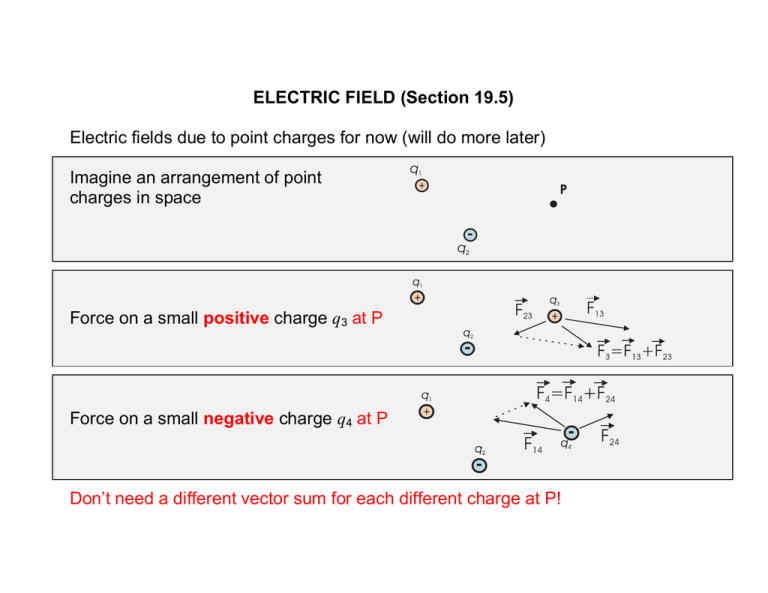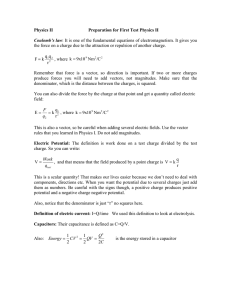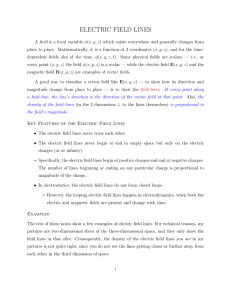ELECTRIC FIELD (Section 19.5) Electric fields due to point charges
advertisement

ELECTRIC FIELD (Section 19.5) Electric fields due to point charges for now (will do more later) Imagine an arrangement of point charges in space Force on a small positive charge q3 at P Force on a small negative charge q4 at P Don’t need a different vector sum for each different charge at P! Force on a small positive charge q3 at P Force on a small negative charge q4 at P Define ELECTRIC FIELD at P: F3 F4 Eat P q3 q 4 Charges q1 and q2 cause an electric field at P The electric field at P is independent of charge at P ELECTRIC FIELDS: IMPORTANT CONCEPTS Any point charge q creates an electric field at all surrounding points in space If the electric field at a point in space is E , then the force on a charge q0 at that point is F q0 E o F is in the same direction as E for positive q0 o F is in the opposite direction from E for negative q0 q If the electric force on a charge 0 at a point in space is known to be F F o then the electric field at that point must be E q 0 o The units of electric field are N/C Force and Electric Field are both VECTORS Direction for Force and Electric Field: another special unit vector r̂ For the ELECTRIC FORCE on a charge at P due to a charge q: Unit vector r̂ points from q → P qq0 F k rˆ e 2 Force is qq0 r o Points in same direction as r̂ if q and q0 have the same sign o Points in opposite direction to r̂ if q and q0 have opposite signs For the ELECTRIC FIELD at P due to a charge q: Fqq0 q ˆ E k e 2 r Electric field at P is P q0 r o Points in same direction as r̂ if q is positive ( E points away from +) q r̂ o Points in opposite direction to if is negative ( E points toward -) Superposition: Because Electric Field is a vector: The total E at any point P due to a particular arrangement of point charges is the VECTOR SUM of the electric field vectors due to all charges around P Total electric field at P is: q rˆ ET k e i 2 i E1 E2 E3 E4 ri i o q i is the charge at i o ri is the distance from q i → P o r̂i is the unit vector from q i → P o the sum is a VECTOR SUM The Electric Dipole is an important arrangement of charges charges q and q separated by distance 2a o Charges in some molecules (polarizable) separate in an electric field Result is an induced electric dipole responsible for van der Waal’s interaction o Many molecules have permanent electric dipoles (i.e. water) o Insulators in which dipoles can be induced are used in capacitors dielectrics Example: (a) Show that the electric field at point P a distance y above the midpoint of an electric dipole aligned along the x-axis is: 2k e q a ˆ EP i 2 2 3/ 2 a y (b) Show that the electric field at point P a distance x along the x-axis from the midpoint of an electric dipole aligned along the x-axis is: 1 1 ˆ EP ke q i 2 2 x a x a (c) Using 1 x n 1 nx nn 1 x 2 , show that for part (b) becomes 2 4k q a E P e3 iˆ x x>>a the answer in For point charges: calculate contributions to total electric field at a point in space from each point charge separately o then find total electric field by doing a vector sum. For a continuous charge distribution (i.e. a line of charge, a charged surface, or a charged volume) Break charge distribution into small elements o treat each element as a point charge. Write a vector sum of contributions from all elements Take limit as elements become infinitesimally small o Sum becomes an INTEGRAL! (but don’t panic. You will be shown how to evaluate) We will come back to do electric fields due to continuous charge distributions later!




